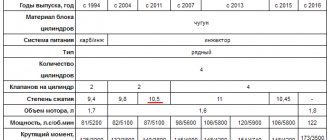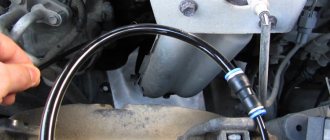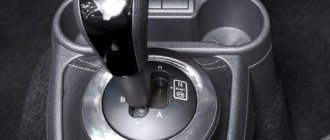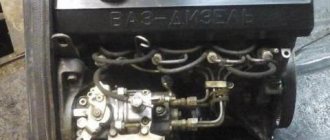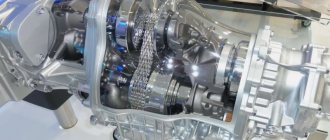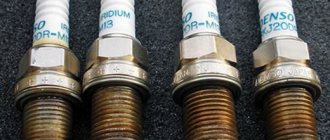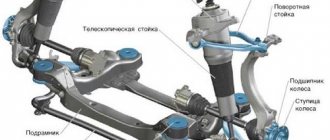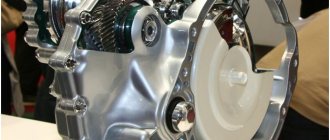5
(1)
How the VTEC system works: location and types VTEC system - The Variable Valve Timing and Lift Electronic Control, an electronically controlled valve phasing system, its presence is determined by the engine model, namely the cylinder head model, oil supply solenoids and ECU engine control unit with distributed injection. The bottom image shows the location on the cylinder head where the VTEC solenoids are located, responsible for activating the long stroke rocker. The second image shows where the VTEC is located - the barrel of the solenoid indicates that the engine has VTEC. There are varieties of single-shaft SOHC VTEC system; unfortunately, the second DOHC VTEC system was not installed on D-series engines D14, D15, D16. VTEC solenoid valve resistance is 14-30 ohms, at 12 volts.
View of the solenoid of a two-stage VTEC system
Location of the solenoid on the cylinder head block of the Honda Civic
What is VTEC, how does VTEC work, the meaning of the system
Simply put, valve timing electronically controlled, or simply VTEC. It’s enough to understand a couple of basics for what it’s needed and everything will fall into place. An ordinary 4-stroke engine draws air from the atmosphere at a pressure of 1 bar, that is, approximately 760 mmHg (This is also 1 atmosphere or 101 kPa). As the revolutions increase, the speed of the piston also increases. At low speeds, the piston sucks in air as cleanly as possible, that is, the piston slowly lowering sucks in the volume with a pressure of 1 atmosphere. As the piston speed increases, the pressure decreases, because there is no longer enough time for the air to be under normal conditions. You've probably seen dyno graphs where peak power is around 5000-6000 rpm, and then the power line drops off. This is because the engine cannot suck in any more air, it is so rarefied (that is, there are few air molecules) that it becomes difficult to spin the engine. There are many possible solutions, remove air resistance by installing a zero filter, cold intake, increasing the throttle diameter, porting the intake channels or pumping air under pressure. But Honda came up with its own way. When the critical point of engine power is reached (approximately 5500 rpm), the VTEC system on the intake valves is activated, which keeps the valves open a little longer than usual, which gives additional time to “suck in” air. now the dead center shifts to the range of 7000. Any work with an intake system such as porting gives an increase in power at the top but can take away points for traction at the bottom, since the torque also shifts to higher speeds, to which you still need to rev the engine, there is very little air a lot of. what to do? choke the engine at low end, reduce air flow by approximately reducing the diameter of the throttle valve. You've probably heard that an 8-valve engine has more low-end potential than a 16-valve engine. This is the same thing. Honda engineers came up with the ECO-VTEC system, the principle of which not only saves fuel but also “strangles” the engine up to 2500 rpm (approximately) in order to extract maximum thrust, with only 12 valves operating.
In total, it turns out that with full VTEC 3-Stage, the bottoms are strangled and have a good torque, then work in the normal 16-valve mode, and activation at high speeds is already VTEC so that more air gets in. That's all you need to know from the basics of VTEC.
AVTEK [edit]
The AVTEC (Advanced VTEC) engine was first announced in 2006. [8] It combines continuously variable valve stroke and variable valve timing with continuously variable valve timing. Honda initially planned to produce vehicles with AVTEC engines within the next 3 years. Although it was supposed to be first used in the 2008 Honda Accord, the car instead uses the existing i-VTEC system. As of the end of 2022, no Honda vehicles use the AVTEC system.
Differences from other VTEC[edit]
Honda's advanced VTEC technology is very different from its previous incarnations as it no longer relies on switching between two sets of cams on a given camshaft. Instead, one cam per valve and two rocker arms per valve are used, with the second rocker arm having a moving pivot point, thereby providing variable cam lift. The advanced VTEC engines continue to use the now standard variable cam engine with variable oil pressure. By combining these two technologies, Honda developed Continuously Variable Valve Timing and Lift (VVTL). Previous versions of VTEC included only staged VVTL, i.e. High-Low. With the introduction of i-VTEC, systems received continuously variable valve timing, but still only stepped lift, i.e. High-Low. The "infinitely variable" part of A-VTEC is what makes it stand out as a major evolutionary step in the VTEC world. [9]
Patent[edit]
The corresponding US patent (6,968,819) was filed on January 5, 2005.[10][11]
Advanced VTEC has a standard camshaft and rocker arms attached as usual with an overhead camshaft and rocker arms pushing poppet valves. The camshaft is surrounded by a partially open drum, to which secondary rocker arms are attached via a pivot point. These secondary rocker arms, which have a variable depth profile (similar to cams), are actuated directly by the camshaft, like scissors. The primary rocker arms are driven by secondary (attached to the drum) rocker arms. The drum will only rotate to advance or decelerate the secondary rocker arms to take advantage of their changing profile. Thus, by changing the position of the drum around its axis, each cam profile is changed to the optimal height for maximum engine performance without sacrificing fuel efficiency at lower speeds. [12]
Working principle of VTEC
I will show you the example of the most famous and simple animation image that explains the principle of operation of VTEC. When the oil pressure in the engine is reached, as well as the speed is reached, usually 5500 RPM, the VTEC valve opens due to the solenoid, which supplies oil to the gas distribution system.
Animated demonstration of part of the VTEC system operation
Oil pressure pushes the “latches” of the rockers, which lock the main and middle rockers. Now the valves open deeper - longer. At the same moment, the fuel and ignition maps are switched in the engine control unit (ECU). Due to the richer mixture and longer opening of the valves, a more powerful impulse appears to push the piston.
Operating principle of VTEC rocker activation
VTEC Valve Opening Duration As you understand, the duration of VTEC valve opening depends on the engine RPM. At approximately 5500 rpm, VTEC turns on, at 4600 (approximately) VTEC turns off. On an automatic transmission up to 4th gear, the activation of VTEC takes no more than 5 seconds, the system is automated and, when the revolutions and speed are reached, it switches gears, which means it resets the RPM. In terms of operating time of the VTEC system, this is only a few seconds, but it is they that give the real gain. Vtek does not turn on in netralka, and in parking mode in automatic and varator.
General concept
To understand what VTEC is, let's look at the differences between regular and sports camshafts. Structurally, both shafts are the same, but the latter has a higher cam height than the usual one, and its geometry is smoother. Due to this cam shape, sports camshafts provide better cylinder filling due to increased valve opening time and height.
VTEC combines the design features of simple and sports camshafts, which allows you to automatically adjust the valve timing depending on the operating conditions of the engine. At low speeds, the system uses cams with a regular geometry, therefore saving fuel, and at high speeds, with an increased height, providing maximum power output.
VTEC 3-Stage: what is it?
Finally, I will talk about the VTEC 3-Stage system (stage 3). This system is also installed in the cylinder head; it was installed after 1996. Has 2 solenoids. It is controlled by 12 volts; when supplied, the oil supply valve opens, if there is, of course, oil pressure. It was installed on a JDM motor D15B, single-shaft SOHC, and of course not a B series. The thing is quite interesting and in demand. It has 3 stages, combines all operating modes of all types of SOHC D series. There were several types of ECUs, but only OBD2 series, below is a list of all p2j 3-Stage ECUs
- OBD2A 37820-P2J-J62 CVT
- OBD2A 37820-P2J-J63 CVT
- OBD2A 37820-P2J-J61 CVT
- OBD2A 37820-P2J-003 Mechanics
- OBD2B 37820-P2J-J11 Mechanical
- OBD2B 37820-P2J-J81 CVT from Vi-RS
- OBD2B 37820-P2J-J71 CVT
Links[edit]
- ^ ab "VTEC engine". Honda Motor Co., Ltd. Retrieved March 11, 2011.
- "Father" VTEC ". Honda Motor Co., Ltd. Archived from the original on May 08, 2009. Retrieved December 4, 2011.
- "Overview of Automotive Taxes" (PDF). Aichi Prefectural Government Office
. Aichi Prefecture. Archived (PDF) from the original on 07/13/2017. Retrieved August 4, 2022. - "VTEC - History and Technology - Honda Tuning Magazine". superstreetonline.com
. May 20, 2009. Retrieved March 27, 2022. - acura.com. acura.com. Archived from the original on June 24, 2008. Retrieved December 4, 2010.
- "Honda Civic Hybrid Technology". Autospeed.com. Archived from the original on July 28, 2011. Retrieved December 4, 2010.
- "Honda Worldwide". world.honda.com. Archived from the original on 2014-05-15. Retrieved November 7, 2012.
- ↑
Nunez, Alex (September 25, 2006). "Honda Introduces Advanced VTEC Engine". Autoblog.com. Retrieved December 4, 2010. - https://www.vtec.net/news/news-item?news_item_id=659664
- Tan, Paul (2007-04-17). "Honda Files Advanced VTEC Patent". paultan.org. Retrieved December 4, 2010.
- “A-VTEC USPTO Violation of Protection Details; TOV analysis". Vtec.net. Retrieved December 4, 2010.
- "U.S. Patent Application No. 11/028,608"
- "Honda Unveils Three New VTEC Turbo Engines, Including Civic Type R 2.0L". autoblog.com
. Archived from the original on March 28, 2022. Retrieved March 27, 2018. - Honda Develops VTEC TURBO Direct Injection Gasoline Turbo Engine It Achieves Class Leading Output and Environmental Performance Archived 2013-12-09 at the Wayback Machine
- "クラストップ環境性能を両立しガソリンターボエン「 VTEC TURBO」を新開発". www.honda.co.jp
. Retrieved March 27, 2022. - "Honda Worldwide | Technology close-up". world.honda.com. Archived from the original on 2011-06-04. Retrieved December 4, 2010.
- https://www.visordown.com/reviews/motorbike/vfr800-vtec-2005-2013-review
- Hanlon, Mike. "Honda Announces New Generation of Motorcycle Engines with Outstanding Fuel Economy and Usability". Retrieved May 28, 2012.
- Beeler, Jensen. “Honda Integra 700 cc engine. See for mid-size motorcycles". Asphalt and rubber. Retrieved May 28, 2012.
General
- "Technology Close Up". Honda Motor Co., Ltd. 2004. Retrieved July 25, 2006.
- "Honda World Technology Close Up". Honda Motor Co., Ltd. 2004. Archived from the original on 2011-06-04. Retrieved July 12, 2007.
- "Honda Worldwide IVTEC Video". Honda Motor Co., Ltd. 2009. Archived from the original on 2014-05-15. Retrieved May 17, 2009.
VTEC 3-Stage: operating principle
How VTEC 3-Stage works, the first stage starts at 0 RPM and ends at 4000 RPM. at this stage the cylinder head operates as VTEC-E. Only 12 valves work. Each cylinder has two exhaust valves but only one intake valve. This allows for economical and smooth acceleration. The next stage is the operation of all 16 valves. The first VTEC solenoid turns on. Normal mode, runs from 4000 to 6000 The last third stage, the second valve is turned on, the intake valves open for a longer period, which allows for more fuel mixture. Work from 6000 to the end point of work The entire system is turned off in the reverse order, first the 2nd solenoid, then 1 solenoid.
Time to get to work
Now that you know how VTEC works, it’s time to install it on your D14A3 or D14A4, I suggest using the translation of the DoDo Joris article that I used, or using my article on installing VTEC. However, good luck with your experiments.
How useful is the publication?
Click on a star to rate!
Average rating 5 / 5. Number of ratings: 1
No ratings yet. Be the first to rate.
Honda Integra
First Generation (1986-1989)
The first generation of Integra debuted in North American markets in 1985, under the name Integra Quint.
The range of produced bodies included: 3 or 5-door hatchback and 4-door sedan. For Australian markets, the car was produced under the name Rover 416i. The Integra was equipped with a 1600 cm3 ZC engine. It had a 16 valve DOHC gas distribution system. The power system included a Carburetor or PGM-FI distributed injection. The Type R version is based on the standard fourth and fifth generation Integra versions, and was created specifically for participation in the National Championship. The model differs from the standard version in a new, stiffer suspension, increased diameter of brake discs, and increased engine power through modifications.
Fourth generation (1995—2001)
Produced in two- and four-door versions, body numbers respectively DC2 and DB8 with a
Fifth generation engine (2001-2005)
This car was produced only in a two-door version in the DC5 body with a new generation K20A engine producing 220 hp. Acceleration time 0-100 km.h. 6.2s. The type-r package includes: 4-piston Brembo brakes (300mm discs), Recaro front seats, differential lock (LSD), Enkei forged wheels, 4 braces to increase body rigidity, steering wheel, pedals and Momo gear knob. It is considered one of the fastest and most maneuverable production front-wheel drive cars in the world.
Material from Wikipedia - the free encyclopedia
Engine bottlenecks, typical malfunctions
As the mileage increases, the camshafts wear out quite rapidly, sometimes oil leaks appear, the airbags begin to get tired, and the revs start to fluctuate. Let's talk in more detail about the problems of a generally reliable and high-torque engine. The most common problems drivers experience are:
- Engine knock. This indicates threshold wear of the exhaust camshaft. A typical problem with the 2.4 di dohc i-vtec engine, since it is forced and increased wear of spare parts that carry the main load is nothing unusual. The camshaft will need to be replaced.
- Or try to eliminate the knocking by adjusting the valve group.
Previously, in the first versions, local overheating of the 4th cylinder was observed, but with revision the issue was resolved. The engine is capricious and consumes only high-quality fuel and proven oil. If you don’t skimp on fuel and consumables, it can easily reach 300 thousand kilometers. During operation it serves for a long time and reliably.
The engine has about 20 modifications and sports versions, which can be easily tuned to specific conditions. There is constant demand for charged sports versions.
Operating principle of VTC
VTC, Variable Timing Control: technology for changing phases (phasing) by turning the intake camshaft relative to the exhaust camshaft using oil pressure. The technology debuted in 2001 (in the US market in 2002).
At high speeds, the time for opening and closing the valves is much less, although more fuel-air mixture needs to be supplied. The VTC system allows you to turn the camshaft for earlier opening of the valves. This helps to ventilate the cylinders more efficiently and thus creates “favorable conditions” for efficient VTEC operation.
Unlike VTEC, which switches modes at a fixed speed, VTC operates constantly and continuously, adjusting the opening timing of the intake valves depending on the engine load.
The actuator of the VTC system is integrated into the intake camshaft pulley. If a regular pulley is a one-piece structure, one piece of metal, then a VTC pulley consists of several parts.
One of the parts is the VTC pulley housing, which is rigidly attached by the timing chain to the exhaust and crankshaft pulleys. The other part is the VTC pulley vane, it is free running inside the VTC pulley and is rigidly attached to the intake camshaft. The cavity inside the VTC pulley housing, in which the vane has free movement, is filled with engine oil. The oil supply to the pulley cavity is organized on both sides of the blade. Thus, by applying oil pressure to one side, we rotate the blade in the other direction. And the movement of the blade directly affects the camshaft with cams and, as a result, changes the angle of the intake cams relative to the exhaust cams.
The role of the controller in this process is played by the VTC solenoid. Receiving engine load data from the control unit (ECU), the solenoid directs oil pressure to one side.
Engine oil is supplied to the VTC solenoid at a certain pressure. Inside the solenoid, the oil direction is divided into two channels - let's call them the red channel and the yellow channel. Both channels lead from the solenoid to the VTC pulley cavity, in which, as stated above, the pulley blade has free movement. The red channel is connected to one side of the shoulder blade, and the yellow channel to the other.
The overlap angle (valve overlap) is the angle of position of the intake valves relative to the exhaust valves (the point in time) at which the intake and exhaust valves are simultaneously open. Depending on engine operating conditions, the solenoid directs oil pressure to either the red or yellow channel, causing the vane to move to one side or the other.
At idle and low speeds (under light load), the VTC system reduces the valve overlap angle to a minimum to keep the engine running smoothly. As the load increases, the system smoothly increases the overlap angle. At high speeds (under heavy load), the system turns the camshaft (increases the overlap angle) to the maximum possible level. The valve overlap angle depends on the engine model and, as a rule, is in the range of 25-50 degrees.
Here is a visual explanation about the design of Japanese VTEC Honda engines.
If you're a car enthusiast, you've probably heard the term "VTEC" but may not know what it means in the auto industry. If so, then there is an interesting explanation for you about the structure of this type of engine, which is produced by the Honda company.
VTEC is an engine with variable valve timing. For example, Honda uses this system in its engines. VTEC is an abbreviation for V ariable valve T iming and lift E lectronic C ontrol.
There are many different systems in the world with a variable gas distribution system (the stroke and timing of valve movement changes).
Essentially, VTEC is a technology that uses an engine's intake and exhaust valves to control the volume (and speed) of gases that enter and exit the cylinders. The Latin letter “V” in the name of the Honda engine means V ariable valve (variable valves).
In most conventional engines, the valve strokes are typically of a standard size. In VTEC engines, the valves can change their stroke between different levels.
The VTEC system, by changing oil pressure, allows you to switch between different cam profiles that push the valves of the power unit. For example, at higher engine speeds, the cam profile allows for increased valve lift. This allows more oxygen to be supplied to the engine cylinders, resulting in more horsepower being generated.
VTEC engines appeared in the late 1980s. Since then, Honda has used these powertrains in many of its vehicles, including the NSX, Integra Type R, S2000 and Civic Type R.
By the way, Honda engines with a variable gas distribution system differ from the same engines from other companies.
Thus, most other manufacturers use increased oil pressure and a change in the angle of the camshaft relative to the pulley to change the valve timing, which allows the system to set a specific ignition (early, late, middle). Honda's VTEC system uses a completely different principle of operation of the gas distribution system.
Explaining this process in words alone is not enough. It’s best, of course, if you watch a few videos explaining what kind of Honda engines with the VTEC system they are.
